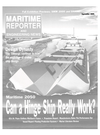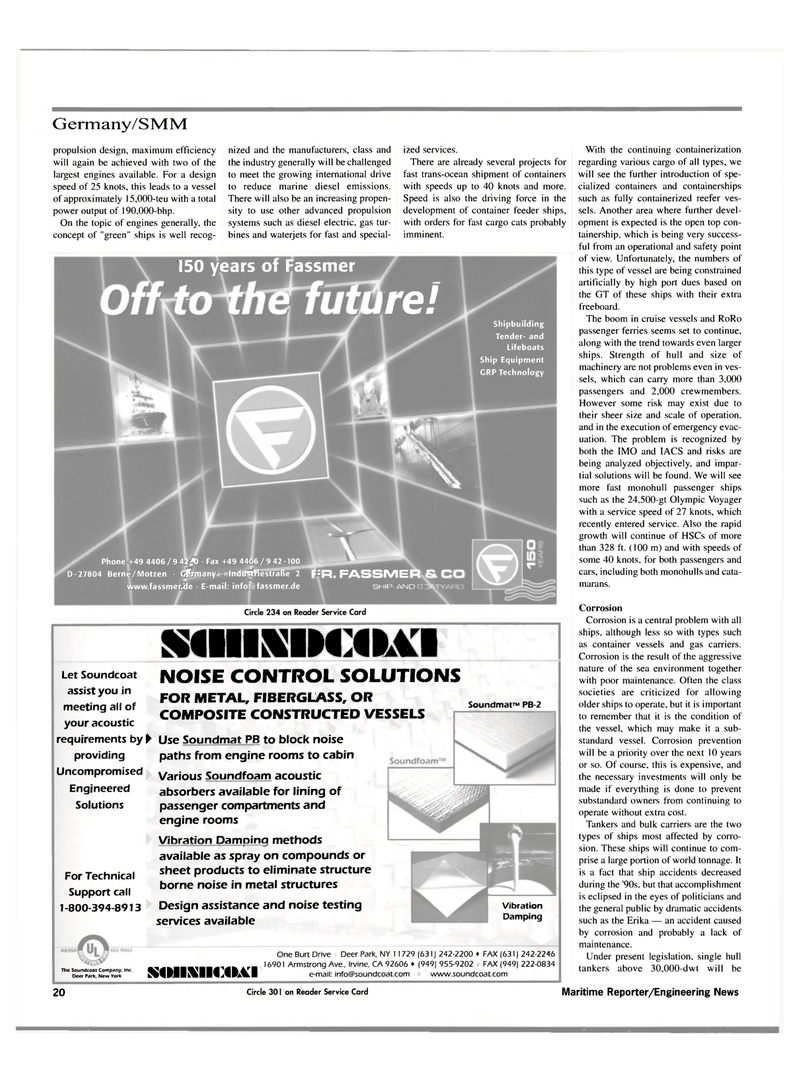
Page 20: of Maritime Reporter Magazine (September 2000)
Read this page in Pdf, Flash or Html5 edition of September 2000 Maritime Reporter Magazine
Germany/SMM propulsion design, maximum efficiency will again be achieved with two of the largest engines available. For a design speed of 25 knots, this leads to a vessel of approximately 15,000-teu with a total power output of 190,000-bhp.
On the topic of engines generally, the concept of "green" ships is well recog- nized and the manufacturers, class and the industry generally will be challenged to meet the growing international drive to reduce marine diesel emissions.
There will also be an increasing propen- sity to use other advanced propulsion systems such as diesel electric, gas tur- bines and waterjets for fast and special-
Circle 234 on Reader Service Card ized services.
There are already several projects for fast trans-ocean shipment of containers with speeds up to 40 knots and more.
Speed is also the driving force in the development of container feeder ships, with orders for fast cargo cats probably imminent.
With the continuing containerization regarding various cargo of all types, we will see the further introduction of spe- cialized containers and containerships such as fully containerized reefer ves- sels. Another area where further devel- opment is expected is the open top con- tainership, which is being very success- ful from an operational and safety point of view. Unfortunately, the numbers of this type of vessel are being constrained artificially by high port dues based on the GT of these ships with their extra freeboard.
The boom in cruise vessels and RoRo passenger ferries seems set to continue, along with the trend towards even larger ships. Strength of hull and size of machinery are not problems even in ves- sels, which can carry more than 3,000 passengers and 2,000 crewmembers.
However some risk may exist due to their sheer size and scale of operation, and in the execution of emergency evac- uation. The problem is recognized by both the IMO and IACS and risks are being analyzed objectively, and impar- tial solutions will be found. We will see more fast monohull passenger ships such as the 24,500-gt Olympic Voyager with a service speed of 27 knots, which recently entered service. Also the rapid growth will continue of HSCs of more than 328 ft. (100 m) and with speeds of some 40 knots, for both passengers and cars, including both monohulls and cata- marans.
Corrosion
Corrosion is a central problem with all ships, although less so with types such as container vessels and gas carriers.
Corrosion is the result of the aggressive nature of the sea environment together with poor maintenance. Often the class societies are criticized for allowing older ships to operate, but it is important to remember that it is the condition of the vessel, which may make it a sub- standard vessel. Corrosion prevention will be a priority over the next 10 years or so. Of course, this is expensive, and the necessary investments will only be made if everything is done to prevent substandard owners from continuing to operate without extra cost.
Tankers and bulk carriers are the two types of ships most affected by corro- sion. These ships will continue to com- prise a large portion of world tonnage. It is a fact that ship accidents decreased during the '90s, but that accomplishment is eclipsed in the eyes of politicians and the general public by dramatic accidents such as the Erika — an accident caused by corrosion and probably a lack of maintenance.
Under present legislation, single hull tankers above 30,000-dwt will be 150 years of Fassmer re!
Phone +49 4406 / 9 42/) • Fax +49 4406 / 9 42-100^
D-27804 Berne/Motzen - (®rjjiany*HinlirafTestfa(5e 2
Www.fassmer.de • E-mail: infofefassmer.de
Shipbuilding
Tender- and
Lifeboats
Ship Equipment
GRP Technology :R. FASSME
SHIP AND 0i 9iilll32IM;OArl
Let Soundcoat assist you in meeting all of your acoustic requirements by i> providing
Uncompromised
Engineered
Solutions
For Technical
Support call 1-800-394-8913
NOISE CONTROL SOLUTIONS
FOR METAL, FIBERGLASS, OR
COMPOSITE CONSTRUCTED VESSELS
Use Soundmat PB to block noise paths from engine rooms to cabin
Various Soundfoam acoustic absorbers available for lining of passenger compartments and engine rooms
Vibration Damping methods available as spray on compounds or sheet products to eliminate structure borne noise in metal structures
Design assistance and noise testing services available
Soundmat™ PB-2
Vibration
Damping
The Soundcoat Company, Inc.
Deer Park, New York KOIIXIICOAI
One Burt Drive Deer Park, NY 1 1729 (631) 242-2200 > FAX (631) 242-2246 16901 Armstrong Ave., Irvine, CA 92606 (949) 955-9202 . FAX (949) 222-0834 e-mail: [email protected] www.soundcoat.com 20 Circle 301 on Reader Service Card Maritime Reporter/Engineering News

 19
19

 21
21
